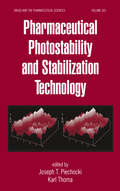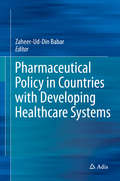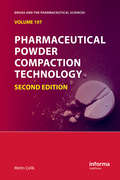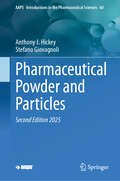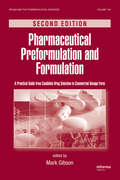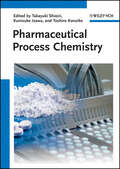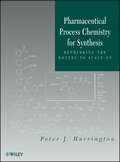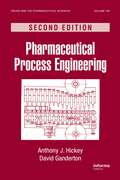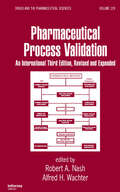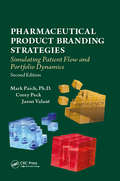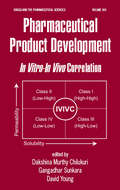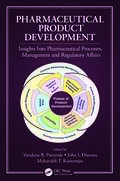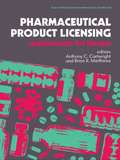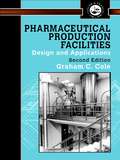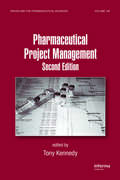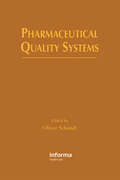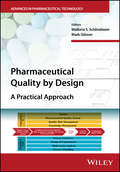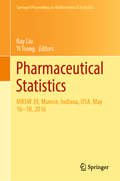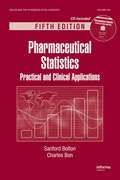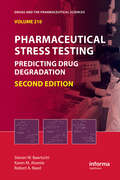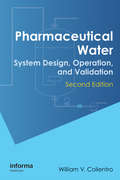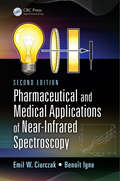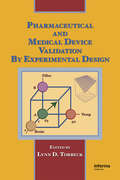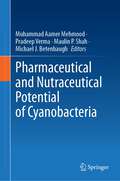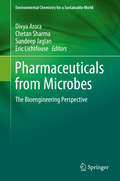- Table View
- List View
Pharmaceutical Photostability and Stabilization Technology
by Joseph T. Piechocki Karl ThomaBased on a training course developed by Dr. Joseph T. Piechocki and other experts in this field whose contributions appear in this book for two International Meetings on the Photostability of Drugs and Drug Products, this text clarifies the guidelines set by the International Conference on Harmonization (ICH) and provides a comprehensive background
Pharmaceutical Policy in Countries with Developing Healthcare Systems
by Zaheer-Ud-Din BabarA comprehensive and granular insight into the challenges of promoting rational medicine, this book serves as an essential resource for health policy makers and researchers interested in national medicines policies. Country-specific chapters have a common format, beginning with an overview of the health system and regulatory and policy environments, before discussing the difficulties in maintaining a medicines supply system, challenges in ensuring access to affordable medicines and issues impacting on rational medicine use. Numerous case studies are also used to highlight key issues and each chapter concludes with country-specific solutions to the issues raised. Written by highly regarded academics, the book includes countries in Africa, Asia, Europe, the Middle East and South America.
Pharmaceutical Powder Compaction Technology (Drugs and the Pharmaceutical Sciences)
by Metin ÇelikCompaction of powder constituents-both active ingredient and excipients-is examined to ensure consistent and reproducible disintegration and dispersion profiles. Revised to reflect modern pharmaceutical compacting techniques, this second edition of Pharmaceutical Powder Compaction Technology guides pharmaceutical engineers, formulation scientists,
Pharmaceutical Powder and Particles (AAPS Introductions in the Pharmaceutical Sciences #60)
by Anthony J. Hickey Stefano GiovagnoliThis book in the AAPS book series concisely reviews important aspects of powder and particle systems and the critical quality attributes that should be used as a guide to future developments intended to maximize the control of product quality and performance. Hickey and Giovagnoli have written an essential book for any scientists involved in powder or particle research and manufacturing. It is appropriate for those just entering the field or as a rapid reference for the experienced pharmaceutical scientist. The authors have both academic and industrial experience, and the coverage includes solid state chemistry; crystallization; physical processes; particle size and distribution; particle interaction; manufacturing processes; quality by design; and a general discussion of the industry. Pharmaceutical Powder and Particles is intended to concisely review important aspects of powder and particle systems and the critical quality attributes that should be used as a guide to future developments intended to maximize the control of product quality and performance. Innovation in manufacturing has expanded the range of options available for solid dosage form manufacture while continuing to rely on first principles of solid-state chemistry and characterization methods for powders and particles. In this new edition, the authors have expanded on existing chapters and added sections on new developments in the recent and evolving manufacturing processes including additive manufacturing technologies, controlled crystallization, spray-freeze-drying technology, and more. The editors have also comprehensively updated the references throughout the entire book.
Pharmaceutical Preformulation and Formulation: A Practical Guide from Candidate Drug Selection to Commercial Dosage Form (Drugs and the Pharmaceutical Sciences)
by Mark GibsonPharmaceutical Preformulation and Formulation: A Practical Guide from Candidate Drug Selection to Commercial Dosage Form reflects the mounting pressure on pharmaceutical companies to accelerate the new drug development and launch process, as well as the shift from developing small molecules to the growth of biopharmaceuticals. The book meets the ne
Pharmaceutical Process Chemistry
by Kunisuke Izawa Toshiro Konoike Takayuki ShioiriCovering the whole area of process chemistry in the pharmaceutical industry, this monograph provides the essential knowledge on the basic chemistry needed for future development and key industrial techniques, as well as morphology, engineering and regulatory compliances. Application-oriented and well structured, the authors include recent examples of excellent industrial production of active pharmaceutical ingredients.
Pharmaceutical Process Chemistry for Synthesis
by Peter J. HarringtonThere is a need to explain that generic versions of a drug may not be manufactured by the same process as brand-name drugs and that the different processes may have dramatically different environmental impacts. Two global forces are at odds today--the push for "greener" processes and the push for lower drug prices. This book brings this conflict into sharp focus by discussing in detail the published process chemistry for top-selling small molecule drugs.Providing insights about process route selection, choice of reagents, and reaction conditions, Pharmaceutical Process Chemistry for Synthesis guides process chemists in identifying best processes for manufacturing these blockbuster drugs as they lose patent protection. Further, it highlights the strategies and methodology that might be useful for expediting the process research and development of the blockbusters of the future.Written from a refreshingly objective perspective, this book is essential for process chemists who need to devise practical syntheses for increasingly complex drugs in a constantly decreasing time frame.
Pharmaceutical Process Engineering (Drugs and the Pharmaceutical Sciences)
by Anthony J. Hickey David GandertonWith step-by-step methods of drug production and knowledge of major unit operations and key concepts of pharmaceutical engineering, this guide will help to improve communication among the varied professionals working in the pharmaceutical industry. Key features: REVISION OF A BESTSELLER - Updates include recent advances in the field to keep pharmac
Pharmaceutical Process Validation: An International (Drugs and the Pharmaceutical Sciences)
by Robert A. Nash Alfred H. WachterThe third edition of this text contains additional chapters which cover troubleshooting procedures, validation in contract manufacturing and current harmonization trends.
Pharmaceutical Product Branding Strategies: Simulating Patient Flow and Portfolio Dynamics
by Mark Paich Corey Peck Jason ValantThis updated Second Edition details how marketers, forecasters, and brand planners can achieve optimal success by building internally consistent simulation models to project future behavior of patients, physicians, and R&D processes. By introducing the reader to the complexities facing many pharmaceutical firms, specifically issues around cross-functional coordination and knowledge integration, this guide provides a framework for dynamic modeling of interest to several pharmaceutical markets, including epidemiology, market definitions, compliance/persistency, and revenue generation in the context of patient flows or movements.
Pharmaceutical Product Development: In Vitro-In Vivo Correlation (Drugs And The Pharmaceutical Sciences Ser. #Vol. 165)
by David Young Chilukuri Dakshina Murthy Gangadhar SunkaraDuring the last two decades, the pharmaceutical industry has been under pressure to reduce development costs and the time needed to bring drugs to market in order to maximize return on investment and bring treatments to patients sooner. To meet these ends, pharmaceutical scientists working in the differing areas of pharmacy, pharmaceutics, and phar
Pharmaceutical Product Development: Insights Into Pharmaceutical Processes, Management and Regulatory Affairs
by Vandana B. Patravale John I. Disouza Maharukh T. RustomjeePharmaceutical product development is a multidisciplinary activity involving extensive efforts in systematic product development and optimization in compliance with regulatory authorities to ensure the quality, efficacy and safety of resulting products.Pharmaceutical Product Development equips the pharmaceutical formulation scientist with extensive
Pharmaceutical Product Licensing: Requirements for Europe
by Anthony C. Cartwright Brian R. MatthewsProvides a systematic account of the major technical, administrative and legal requirements for registering a product in any of the national markets within the EEC, using the existing procedures, with guidance as to how these procedures are likely to change after 1992.
Pharmaceutical Production Facilities: Design and Applications
by Basant Puri Roger Ho Annie HallPharmaceutical Production Facilities: Design and Applications considers the concepts and constraints that have to be considered in the design of small, medium and large scale production plants. The layout, along with the flow of materials and personnel through facilities are considered with reference to ensuring compliance with current good manufac
Pharmaceutical Project Management (ISSN)
by Tony KennedyEncompassing the full spectrum of project management's role and responsibility encountered in the pharmaceutical industry, Pharmaceutical Project Management outlines the key objectives, risks, and challenges of each stage of the pharmaceutical lifecycle, from discovery and preclinical phases through clinical development, manufacturing, registration
Pharmaceutical Quality Systems
by Oliver SchmidtWhen a pharmaceutical company decides to build a Quality System, it has to face the fact that there aren't any guideline that define exactly how such a system has to be built. With terms such as quality system, quality assurance, and quality management used interchangeably, even defining the system's objectives is a problem. This book provides a pr
Pharmaceutical Quality by Design: A Practical Approach
by Walkiria S. Schlindwein Mark GibsonA practical guide to Quality by Design for pharmaceutical product development Pharmaceutical Quality by Design: A Practical Approach outlines a new and proven approach to pharmaceutical product development which is now being rolled out across the pharmaceutical industry internationally. Written by experts in the field, the text explores the QbD approach to product development. This innovative approach is based on the application of product and process understanding underpinned by a systematic methodology which can enable pharmaceutical companies to ensure that quality is built into the product. Familiarity with Quality by Design is essential for scientists working in the pharmaceutical industry. The authors take a practical approach and put the focus on the industrial aspects of the new QbD approach to pharmaceutical product development and manufacturing. The text covers quality risk management tools and analysis, applications of QbD to analytical methods, regulatory aspects, quality systems and knowledge management. In addition, the book explores the development and manufacture of drug substance and product, design of experiments, the role of excipients, multivariate analysis, and include several examples of applications of QbD in actual practice. This important resource: Covers the essential information about Quality by Design (QbD) that is at the heart of modern pharmaceutical development Puts the focus on the industrial aspects of the new QbD approach Includes several illustrative examples of applications of QbD in practice Offers advanced specialist topics that can be systematically applied to industry Pharmaceutical Quality by Design offers a guide to the principles and application of Quality by Design (QbD), the holistic approach to manufacturing that offers a complete understanding of the manufacturing processes involved, in order to yield consistent and high quality products.
Pharmaceutical Statistics: MBSW 39, Muncie, Indiana, USA, May 16-18, 2016 (Springer Proceedings in Mathematics & Statistics #218)
by Yi Tsong Ray LiuThis book presents the proceedings of the 39th annual Midwest Biopharmaceutical Statistics Workshop (MBSW), held in Muncie, Indiana on May 16–18, 2016. It consists of selected peer- reviewed and revised papers on topics ranging from statistical applications in drug discovery and CMC to biomarkers, clinical trials, and statistical programming. All contributions feature original research, and together they cover the full spectrum of pharmaceutical R&D – with a special focus on emergent topics such as biosimilarity, bioequivalence, clinical trial design, and subgroup identification.Founded in 1978, the MBSW has provided a forum for statisticians to share knowledge, research, and applications on key statistical topics in pharmaceutical R&D for almost forty years, with the 2016 conference theme being “The Power and 3 I’s of Statistics: Innovation, Impact and Integrity.” The papers gathered here will be of interest to all researchers whose work involves the quantitative aspects of pharmaceutical research and development, including pharmaceutical statisticians who want to keep up-to-date with the latest trends, as well as academic statistics researchers looking for areas of application.
Pharmaceutical Statistics: Practical and Clinical Applications, Fifth Edition (Drugs and the Pharmaceutical Sciences)
by Sanford Bolton Charles BonThrough the use of practical examples and solutions, Pharmaceutical Statistics: Practical and Clinical Applications, Fifth Edition provides the most complete and comprehensive guide to the various statistical applications and research issues in the pharmaceutical industry, particularly in clinical trials and bioequivalence studies.
Pharmaceutical Stress Testing: Predicting Drug Degradation, Second Edition (ISSN)
by Steven W. Baertschi Karen M. Alsante Robert A. ReedThe second edition of Pharmaceutical Stress Testing: Predicting Drug Degradation provides a practical and scientific guide to designing, executing and interpreting stress testing studies for drug substance and drug product. This is the only guide available to tackle this subject in-depth. The Second Edition expands coverage from chemical stability
Pharmaceutical Water: System Design, Operation, and Validation, Second Edition
by William V. CollentroA major new work on all aspects of water, the most used raw material ingredient in the pharmaceutical and biotechnology industries-used as an excipient in pharmaceutical formulations, as a cleaning agent, and as a separately packaged product diluent.Drawing on the author's extensive field experience with more than 400 pharmaceutical and related wat
Pharmaceutical and Medical Applications of Near-Infrared Spectroscopy
by Emil W. Ciurczak Benoit IgneSince the completion of the first edition of this book, major developments have occurred in the pharmaceutical industry that have shaped the field of near-infrared (NIR) spectroscopy. A new initiative from the U.S. Food and Drug Administration (FDA) to modernize regulations of pharmaceutical manufacturing and drug quality has helped position NIR sp
Pharmaceutical and Medical Device Validation by Experimental Design
by Lynn D. TorbeckThis title demonstrates how designed experiments are the most scientific, efficient, and cost effective method of data collection for validation in a laboratory setting. Intended as a learn-by-example guide, Pharmaceutical and Medical Device Validation by Experimental Design demonstrates why designed experiments are the most logical and rational ap
Pharmaceutical and Nutraceutical Potential of Cyanobacteria
by Maulin P. Shah Pradeep Verma Michael J. Betenbaugh Muhammad Aamer MehmoodCyanobacteria are the extraordinary microbes that are believed to have started life on Earth. It's been billions of years since they colonized this planet. Now, the question arises, what has made them so successful? The answer to this question lies in their remarkable potential to survive unfavorable environments, their substantial ability to fix the atmospheric carbon through photosynthesis, and their amazing secondary metabolites having antioxidant, osmo-protectants, and stress-tolerance abilities. Research on cyanobacteria has shown that these secondary metabolites and the substantial photosynthetic rates of cyanobacteria can be exploited for environmental, industrial, nutraceutical, and pharmaceutical applications. This book “Pharmaceutical and Nutraceutical Potential of Cyanobacteria” is a collection of 14 book chapters that have covered almost all aspects related to the opportunities, challenges, and potential applications whileemploying cyanobacteria as feedstock for various industrial and environmental applications with a special focus on pharmaceutical and nutraceutical applications. Some sections have also covered the enhanced biosynthesis, extraction, storage, and marketing of the cyanobacterial bioactive compounds (phycobilins, carotenoids, fatty acids, amino acids), and applications of cyanobacteria as food/feed of the future. We believe that this book will provide substantial learning opportunities to the readers including graduate students, academicians, phycologists, policymakers, environmental entrepreneurs, and industrialists. This book could be included in SDG 12 publications.
Pharmaceuticals from Microbes: Impact On Drug Discovery (Environmental Chemistry for a Sustainable World #28)
by Eric Lichtfouse Divya Arora Chetan Sharma Sundeep JaglanThis book has been assembled with the hope of being an authoritative, comprehensive, conceptually sound and highly informative compilation of recent advances describing the concepts of bioengineering in the field of microbiology. It comprises of seven chapters written by eminent authors in their respective fields. Topics included deal with the significant advancement of microbial technology with emphasis on drug delivery strategies for healthcare products, vaccine delivery, biotransformation approaches to generate new molecules, upstream/downstream processing of biopharmaceuticals. It serves as excellent reference material for researchers, students and academicians in the fields of biotechnology, microbiology and pharmaceutical sciences.
